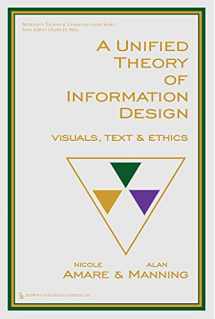
A Unified Theory of Information Design: Visuals, Text and Ethics (Baywood's Technical Communications)
ISBN-13:
9780895037787
ISBN-10:
0895037785
Edition:
1
Author:
Alan Manning, Nicole Amare
Publication date:
2013
Publisher:
Routledge
Format:
Hardcover
215 pages
FREE US shipping
Book details
ISBN-13:
9780895037787
ISBN-10:
0895037785
Edition:
1
Author:
Alan Manning, Nicole Amare
Publication date:
2013
Publisher:
Routledge
Format:
Hardcover
215 pages
Summary
A Unified Theory of Information Design: Visuals, Text and Ethics (Baywood's Technical Communications) (ISBN-13: 9780895037787 and ISBN-10: 0895037785), written by authors
Alan Manning, Nicole Amare, was published by Routledge in 2013.
With an overall rating of 3.5 stars, it's a notable title among other
books. You can easily purchase or rent A Unified Theory of Information Design: Visuals, Text and Ethics (Baywood's Technical Communications) (Hardcover) from BooksRun,
along with many other new and used
books
and textbooks.
And, if you're looking to sell your copy, our current buyback offer is $0.3.
Description
Communicative visuals, including written text, have a diverse range of forms and purposes. In this volume, the authors show that it is possible to both describe and explain the major properties of diverse visual-communication forms and purposes within a common theoretical framework of information design and ethics. For those unaccustomed to thinking of written text as a visual form belonging to the same general class as other visual forms (colour, texture, shape, imagery, etc.), consider how a text's readability suffers if we remove all white space and punctuation, which can be identified as visual signals of the same subtype as grid lines and bullet points, dividing and calling attention to adjacent information. The authors identify deep connections between foundational visual design elements and the grammar of language itself. No physicist or chemist today questions the value of a single theory that describes and explains a wide variety of phenomena, but oddly enough, the authors have frequently been asked why they are interested in advancing a unified theory of visual communication. The simplest answer is: to treat visual communication as a science, and seeking unified theories is just what science does. In more practical terms, a unified approach to visual communication allows us to teach visual design students relatively few things that will enable them to do relatively many things.


We would LOVE it if you could help us and other readers by reviewing the book
Book review

Congratulations! We have received your book review.
{user}
{createdAt}
by {truncated_author}


